Panasonic CF-T4 User Manual

OPERATING INSTRUCTIONS
Personal Computer
Model No. CF-T4 Series
XP
|
|
|
|
|
1 |
For first-time and basic opera- |
|
|
|
|
|
|
|
tion, refer to the Operating |
|
|
|
Instructions (this manual). |
|
|
|
|
|
|
|
|
|
2 |
For more information on how |
||
to use this computer, refer to |
|||
the onscreen Reference Man- |
|||
ual. |
|||
Î page 11
For your technical support office, refer to “LIMITED WARRANTY.”
Contents |
|
|
|
Preparations |
Page |
|
|
|
|||
Read Me First .............................................................. |
3 |
Preparations |
|
How to Use this Manual |
11 |
||
|
|||
Names and Functions of Parts.................................. |
12 |
|
|
First-time Operation .................................................. |
14 |
|
|
|
|
||
|
|
||
Getting Started (Basic Operations) |
Started |
||
Starting Up/Shutting Down |
19 |
||
|
|||
Using the Touch Pad................................................. |
23 |
Getting |
|
Expanding Memory |
24 |
||
|
|||
Useful Information |
|
|
|
|
|
||
26 |
Information |
||
Usage/Handling/Maintenance |
|||
|
|||
Wireless LAN ............................................................ |
28 |
|
|
Windows/Antivirus Protection ................................... |
29 |
Useful |
|
Use of Peripheral Devices/Internal Hard Disk |
32 |
||
|
|||
|
|
|
|
|
|
|
|
Troubleshooting |
33 |
Troubleshooting |
|
|
|||
List of Error Codes.................................................... |
|
||
Dealing with Problems (Summary) ........................... |
34 |
|
|
Reinstalling Software ................................................ |
40 |
|
|
Important Information |
|
|
|
|
|
||
50 |
Information |
||
When Disposing of This Computer .......................... |
|||
LIMITED USE LICENSE AGREEMENT ................... |
44 |
|
|
Hard Disk Backup Function ...................................... |
46 |
|
|
Specifications............................................................ |
52 |
Important |
|
LIMITED WARRANTY |
54 |
||
|
|||
|
|
|
|

Customer’s Record
Model No.*1
Serial No.
or
Code No.
Date of Purchase
Dealer’s Name
Dealer’s Address
*1 For the Model No., insert the 12 digit number (for example, CF-T4GWCTZBM) located on the bottom of the computer.
Introduction
Thank you for purchasing the Panasonic computer. Read this manual thoroughly for proper operation of your new computer.
Copyright
This manual is copyrighted by Matsushita Electric Industrial Co., Ltd. with all rights reserved. No part of this manual may be reproduced in any form without the prior written permission of Matsushita Electric Industrial Co., Ltd.
No patent liability is assumed with respect to the use of the information contained herein. © 2005 Matsushita Electric Industrial Co., Ltd. All Rights Reserved.
Disclaimer
Computer specifications and manuals are subject to change without notice. Matsushita Electric Industrial Co., Ltd. assumes no liability for damage incurred directly or indirectly from errors, omissions or discrepancies between the computer and the manuals.
Trademarks
Microsoft, Windows and the Windows logo are registered trademarks of Microsoft Corporation of the United States and/or other countries.
Intel, Pentium and PROSet are either registered trademarks or trademarks of Intel Corporation.
SD Logo is a trademark. 

Adobe, the Adobe logo and Adobe Reader are either registered trademarks or trademarks of Adobe Systems Incorporated in the United States and/or other countries.
Panasonic is a registered trademark of Matsushita Electric Industrial Co., Ltd.
Names of products, brands, etc., appearing in this manual are trademarks or registered trademarks of their respective owner companies.
Illustrations and Terminology in this Manual
|
|
|
|
|
Notations |
|
|
|
Meanings |
|
|
NOTE |
NOTE provides a useful fact or helpful information. |
||||||||
|
CAUTION |
CAUTION indicates a condition that may result in minor or a moderate degree of |
||||||||
|
|
|
|
|
|
injury. |
||||
|
Enter |
|
|
This illustration means pressing the |
Enter |
key. |
||||
|
Fn |
+ |
F5 |
|
This illustration refers to pressing and holding the Fn key, then pressing the F5 key. |
|||||
|
|
|
|
|
|
When using with the |
Fn |
and Ctrl functions interchanged, read with Fn and Ctrl |
||
|
|
|
|
|
|
reversed. |
||||
|
[start] - [Run] |
This illustration tells you to click [start], then to click [Run]. |
||||||||
Î |
|
|
|
|
This symbol indicates related pages. |
|||||
|
|
|
|
|
|
|
|
|
|
|
zSome of the illustrations in this manual may differ slightly in shape from the actual items on your computer. This should make the explanation easier to understand.
zIf a user has logged on to Windows without the Administrator Authority, some functions may not be executable, and some screens may not be displayed as shown in this manual.
If this happens, log-on to Windows with the Administrator Authority to enable these functions.
zIn this manual, “Microsoft® Windows® XP Professional Service Pack 2 with Advanced Security Technologies” is indicated as “Windows” or “Windows XP.”
zOptional Products or Accessories
Confirm the latest information on optional products or accessories from other sources.
2

Read Me First
For U.S.A.
Federal Communications Commission Radio Frequency Interference Statement
Note: This equipment has been tested and found to comply with the limits for a Class B digital device, pursuant to Part 15 of the FCC Rules. These limits are designed to provide reasonable protection against harmful interference in a residential installation. This equipment generates, uses and can radiate radio frequency energy and, if not installed and used in accordance with the instructions, may cause harmful interference to radio communications. However, there is no guarantee that interference will not occur in a particular installation. If this equipment does cause harmful interference to radio or television reception, which can be determined by turning the equipment off and on, the user is encouraged to try to correct the interference by one or more of the following measures:
zReorient or relocate the receiving antenna.
zIncrease the separation between the equipment and receiver.
zConnect the equipment into an outlet on a circuit different from that to which the receiver is connected.
zConsult the Panasonic Service Center or an experienced radio/TV technician for help.
Warning
To assure continued compliance, use only shielded interface cables when connecting to a computer or peripheral. Also, any changes or modifications not expressly approved by the party responsible for compliance could void the user’s authority to operate this equipment.
FCC RF Exposure Warning:
zThis computer is provided with a PC Card slot that could be used with wireless transmitter(s), which will be specifically recommended, when they become available. Other third-party wireless transmitter(s) have not been RF exposure evaluated for use with this computer and may not comply with FCC RF exposure requirements.
zThis equipment complies with FCC radiation exposure limits set forth for an uncontrolled environment.
zThis equipment must be installed and operated in accordance with provided instructions and minimum 1.5 cm spacing must be provided between antenna and all person’s body (excluding extremities of hands, wrist and feet) during wireless modes of operation.
zThis transmitter must not be co-located or operated in conjunction with any other antenna or transmitter.
This product is restricted to indoor use due to its operation in the 5.15 to 5.25 GHz frequency range.
FCC requires this product to be used indoors for the frequency range 5.15 to 5.25 GHz to reduce the potential for harmful interference to co-channel Mobile Satellite systems.
High power radars are allocated as primary users of the 5.25 to 5.35 GHz and 5.65 to 5.85 GHz bands. These
radar stations can cause interference with and /or damage this product.
This device complies with Part 15 of the FCC Rules. Operation is subject to the following two conditions:
(1)This device may not cause harmful interference, and
(2)This device must accept any interference received, including interference that may cause undesired operation.
Responsible Party: Panasonic Corporation of North America
One Panasonic Way
Secaucus, NJ 07094
Tel No:1-800-LAPTOP5 (1-800-527-8675)
FCC Regulation Notice for modem
This equipment contains a FCC approved modem.
1.This equipment complies with CFR47 Part 68 rules. On the computer is a label that contains, among other information, the FCC registration number and ringer equivalence number (REN) for this equipment. If required, this information must be provided to the telephone company.
2.An FCC compliant telephone cord and modular plug is provided with this equipment. This equipment is designed to be connected to the telephone network or premises wiring using a compatible modular jack which is Part 68 compliant. See Installation Instructions for details.
3.The REN is used to determine the quantity of devices which may be connected to the telephone line. Excessive RENs on the telephone line may result in the devices not ringing in response to an incoming call. In most, but not all area, the sum of RENs should not exceed five (5.0). To be certain of the number of devices that may be connected to a line, as determined by the total RENs, contact the local telephone company.
4.If your telephone equipment cause harm to the telephone network, the telephone company will notify you in advice that temporary discontinuance of service may be required. But if advice notice isn’t practical, the telephone company will notify the customer as soon as possible. Also, you will be advised of your right to file a complaint with the FCC if you believe it is necessary.
5.The telephone company may take changes in its facilities, equipment, operations or procedures that could affect the operation of the equipment. If this happens the telephone company will provide advance notice in order for you to make necessary modifications to maintain uninterrupted service.
Preparations
3

Read Me First
Preparations
6.If trouble is experienced with this equipment, for repair or warranty information, please contact Panasonic Corporation of North America at DIAL TOLL FREE 1- 800-LAPTOP5 (1-800-527-8675). If the equipment is causing harm to the telephone network, the telephone company may request that you disconnect the equipment until the problem is resolved.
7.There are no user serviceable parts contained in this equipment.
8.This equipment may not be used on coin service provided by the telephone company. Connection to party lines is subject to state tariffs.
9.The Telephone Consumer Protection Act of 1991 makes it unlawful for any person to use a computer or other electronic device to send any message via a telephone fax machine unless such message clearly contains in a margin at the top or bottom of each transmitted page or on the first page of the transmission, the date and time it is sent and an identification of the business or other entry, or other individual sending the message and the telephone number of the sending machine or such business, other entity, or individual. In order to program this information into your fax software, you should refer to the manual of the Fax software being used.
For Canada
Industry Canada (IC) Notice for modem
This equipment contains an Industry Canada approved modem unit.
The Industry Canada label is affixed on the modem unit.
EQUIPMENT ATTACHMENT LIMITATIONS
“NOTICE: The Industry Canada label identifies certified equipment. This certification means that the equipment meets telecommunications network protective, operational and safety requirements as prescribed in the appropriate Terminal Equipment Technical Requirements document(s). The Department does not guarantee the equipment will operate to the user’s satisfaction.
Before installing this equipment, users should ensure that it is permissible to be connected to the facilities of the local telecommunications company. The equipment must also be installed using an acceptable method of connection. The customer should be aware that compliance with the above conditions may not prevent degradation of service in some situations.
Repairs to certified equipment should be coordinated by a representative designated by the supplier. Any repairs or alterations made by the user to this equipment, or equipment malfunctions, may give the telecommunications company cause to request the user to disconnect the equipment.
Users should ensure for their own protection that the electrical ground connections of the power utility, telephone lines and internal metallic water pipe system, if present, are connected together. This precaution may be particularly important in rural areas. Caution: Users should not attempt to make such connections themselves, but should
10.According to the FCC’s electrical safety advisory, we recommend that you may install an AC surge arrestor in the AC outlet to which this equipment is connected. Telephone companies report that electrical surges, typically lightning transients, are very destructive to customer terminal equipment connected to AC power sources and that this is a major nationwide problem.
“Caution: To reduce the risk of fire, use only No.26 AWG or larger telecommunication line cord.”
“ATTENTION: Pour réduire le risque d’incendie, utiliser uniquement des conducteurs de télécommunications 26 AWG ou de section supérieure.”
Notice for the products using LCD
This product uses one or more fluorescent lamps containing a small amount of mercury. It also contains lead in some components. Disposal of these materials may be regulated in your community due to environmental considerations. For disposal or recycling information please contact your local authorities, or the Electronics Industries Alliance: <http://www.eiae.org/>
contact the appropriate electric inspection authority, or electrician, as appropriate.” “NOTICE: The Ringer Equivalence Number (REN) assigned to each terminal device provides an indication of the maximum number of terminals allowed to be connected to a telephone interface. The termination on an interface may consist of any combination of devices subject only to the requirement that the sum of the Ringer Equivalence Numbers of all the devices does not exceed 5.”
REN: See bottom of the computer
RESTRICTIONS CONCERNANT LE RACCORDEMENT DE MATÉRIEL
"AVIS: L'étiquette d'Industrie Canada identifie le matériel homologué. Cette étiquette certifie que le matériel est conforme aux normes de protection, d'exploitation et de sécurité des réseaux de télécommunications, comme le prescrivent les documents concernant les exigences techniques relatives au matériel terminal. Le Ministère n'assure toutefois pas que le matériel fonctionnera à la satisfaction de l'utilisateur.
Avant d'installer ce matériel, l'utilisateur doit s'assurer qu'il est permis de le raccorder aux installations de l'entreprise locale de télécommunication. Le matériel doit également être installé en suivant une méthode acceptée de raccordement. L'abonné ne doit pas oublier qu'il est possible que la conformité aux conditions énoncées ci-dessus n'empêche pas la dégradation du service dans certaines situations.
Les réparations de matériel homologué doivent être coordonnées par un représentant désigné par le fournisseur.
4

L'entreprise de télécommunications peut demander à l'utilisateur de débrancher un appareil à la suite de réparations ou de modifications effectuées par l'utilisateur ou à cause de mauvais fonctionnement.
Pour sa propre protection, l'utilisateur doit s'assurer que tous les fils de mise à la terre de la source d'énergie électrique, des lignes téléphoniques et des canalisations d'eau métalliques, s'il y en a, sont raccordés ensemble. Cette précaution est particulièrement importante dans les régions rurales. Avertissement: L'utilisateur ne doit pas tenter de faire ces raccordements lui-même; il doit avoir recours à un service d'inspection des installations électriques, ou à un électricien, selon le cas."
"AVIS: L'indice d'équivalence de la sonnerie (IES) assigné à chaque dispositif terminal indique le nombre maximal de terminaux qui peuvent être raccordés à une interface. La terminaison d'une interface téléphonique peut consister en une combinaison de quelques dispositifs, à la seule condition que la somme d'indices d'équivalence de la sonnerie de touts les dispositifs n'excède pas 5."
IES: Voir sous le fond de l'ordinateur
Industry Canada
This product complies with RSS210 Industry Canada. Operation is subject to the following two conditions;
(1)this device may not cause interference, and
(2)this device must accept any interference, including interference that may cause undesired operation of the device.
This product (local network devices) for the band 51505250 MHz is only indoor usage to reduce potential for harmful interference to co-channel Mobile Satellite systems.
High power radars are allocated as primary users (meaning they have priority) of 5250-5350 MHz and 5650-5850 MHz and these radars could cause interference and/or
damage to LELAN devices.
Preparations
Important Safety Instructions / Importantes Mesures De Sécurité
When using your telephone equipment, basic safety precautions should always be followed to reduce the risk of fire, electric shock and injury to persons, including the following:
1.Do not use this product near water, for example, near a bath tub, washbowl, kitchen sink or laundry tub, in a wet basement or near a swimming pool.
2.Avoid using a telephone (other than a cordless type) during an electrical storm. There may be a remote risk of electric shock from lightning.
3.Do not use the telephone to report a gas leak in the vicinity of the leak.
4.Use only the power cord and batteries indicated in this manual. Do not dispose of batteries in a fire. They may explode. Check with local codes for possible special disposal instructions.
SAVE THESE INSTRUCTIONS
Certaines mesures de sécurité doivent être prises pendant l’utilisation de matérial téléphonique afin de réduire les risques d’incendie, de choc électrique et de blessures. En voici quelquesunes:
1.Ne pas utiliser l’appareil près de l’eau, p.ex., près d’une baignoire, d’un lavabo, d’un évier de cuisine, d’un bac à laver, dans un sous-sol humide ou près d’une piscine.
2.Éviter d’utiliser le téléphone (sauf s’il s’agit d’un appareil sans fil) pendant un orage électrique. Ceci peut présenter un risque de choc électrique causé par la foudre.
3.Ne pas utiliser l’appareil téléphonique pour signaler une fuite de gaz s’il est situé près de la fuite.
4.Utiliser seulement le cordon d’alimentation et le type de piles indiqués dans ce manual. Ne pas jeter les piles dans le feu: elles peuvent exploser. Se conformer aux règlements pertinents quant à l’élimination des piles.
CONSERVER CES INSTRUCTIONS
5

Read Me First
Preparations
Information to the User
This product and your Health
This product, like other radio devices, emits radio frequency electromagnetic energy. The level of energy emitted by this product however is far much less than the electromagnetic energy emitted by wireless devices like for example mobile phones.
Because this product operates within the guidelines found in radio frequency safety standards and recommendations, we believe this product is safe for use by consumers. These standards and recommendations reflect the consensus of the scientific community and result from deliberations of panels and committees of scientists who continually review and interpret the extensive research literature.
In some situations or environments, the use of this product may be restricted by the proprietor of the building or responsible representatives of the organization. These situations may for example include:
zUsing this product on board of airplanes, or
zIn any other environment where the risk of interference to other devices or services is perceived or identified as harmful.
If you are uncertain of the policy that applies on the use of wireless devices in a specific organization or environment (e.g. airports), you are encouraged to ask for authorization to use this product prior to turning on the product.
Regulatory Information
We are not responsible for any radio or television interference caused by unauthorized modification of this product. The correction of interference caused by such unauthorized modification will be the responsibility of the user. We and its authorized resellers or distributors are not liable for damage or violation of government regulations that may arise from failing to comply with these guidelines.
Lithium Battery
Lithium Battery!
This computer contains a lithium battery to enable the date, time, and other data to be stored. The battery should only be exchanged by authorized service personnel.
Warning! A risk of explosion from incorrect installation or misapplication may possibly occur.
Pile au lithium!
Le micro-ordinateur renferme une pile au lithium qui permet de sauvegarder certaines données, notamment la date et l’heure. La pile ne doit être remplacée que par un technicien qualifié.
Danger! Risque d’explosion en cas de non respect de cette mise en garde!
6

For Europe
(For models with a “CE” mark on the bottom of the computer)
Declaration of Conformity (DoC)
“Hereby, we declare, that this Personal Computer is in compliance with the essential requirements and other relevant provisions of the Directive 1999/5/EC.”
Hint:
If you want to get a copy of the original DoC of our products which relates to the R&TTE, please contact to our web address: http://www.doc.panasonic.de
Contact:
Panasonic Services Europe
A Division of Panasonic Marketing Europe GmbH
Panasonic Testing Centre
Network connection.
The terminal equipment is intended for connection to the following public network;
In all the countries of European Economical Area;
-Public Switched Telephony Networks
Technical Features.
The terminal equipment includes the following features;
-DTMF dialing
-Maximum bitrate receiving mode: 56 kbit/s
-Maximum bitrate sending mode: 33.6 kbit/s
This product is designed to interwork with the Public Switched Telecommunication Networks in UK, Ireland, Netherlands, Sweden, Denmark, Finland, Switzerland, Luxembourg, Belgium, France, Germany, Spain, Portugal, Iceland, Greece, Italy, Norway and Austria.
-------------------------------------------------------------------------------------------------------------------------------------------
Compliance Notice - CE Mark
This equipment is in conformance with the requirements of the European Council Directive listed below:
73/23/EEC Low Voltage Directive with amendment 93/68/EEC 89/336/EEC EMC Directive with amendments 92/31/EEC and 93/68/EEC 1999/5/EC R&TTE
-------------------------------------------------------------------------------------------------------------------------------------------
Preparations
7

Read Me First
Preparations
Precautions
Usage
Avoid Extreme Heat and Cold
Do not store or use the computer in locations exposed to heat, direct sunlight, or extreme cold.
Avoid moving the computer between locations with large temperature difference.
Operation: 5 °C to 35 °C {41 °F to 95 °F} Storage: -20 °C to 60 °C {- 4 °F to 140 °F}
Avoid Direct Sunlight on the LCD Panel
The LCD panel should not be exposed to direct sunlight or ultraviolet light.
Avoid Humidity, Liquids and Dust
Do not store or use the computer in locations exposed to high humidity, liquids (including rain) or dust.
Prevent Shock
Avoid subjecting the computer to severe vibrations or impact. Do not place the computer inside a car trunk.
Avoid Radio Frequency Interference
Do not place the computer near a television or radio receiver.
Avoiding Low-temperature Burns*1
Avoid more than casual contact with any heat producing area of the notebook computer, AC adaptor, and any option or accessory you use with it. Even low heat, if warmer than body temperature, can cause a burn, if the skin is exposed to the heat source for a long period of time.
Do not touch the computer and cable when it starts thundering
Keep SD memory cards (sold separately) away from infants and small children
Accidental swallowing will result in bodily injury. In the event of accidental swallowing, see a doctor immediately.
Do not connect a telephone line, or a network cable other than the one specified, into the LAN port
If the LAN port is connected to a network such as the ones listed below, a fire or electric shock may result.
•Networks other than 100BASE-TX or 10BASE-T
•Phone lines (Telephone lines, internal phone lines (on-premise switches), digital public phones, etc.)
Handling
Avoid Magnetic Fields
Keep the computer away from magnets. Data stored on the hard disk may be lost.
Avoid Stacking
Do not place heavy objects on top of the computer.
Do Not Disassemble the Computer
Do not disassemble the computer using methods other than those shown in this manual.
This computer contains high-voltage parts, contact with which may result in electrical shock. Modification or incorrect disassembly may result in fire.
Avoid Excessive Force on the Display
Do not apply excessive downward force on the display.
If a malfunction occurs, immediately unplug the AC cord and the battery pack
• Computer is damaged
•Foreign object inside computer
•Smoke emitted
•Unusual smell emitted
•Unusually hot
Continuing to use the computer while any of the above conditions are present may result in fire or electrical shock.
zIf a malfunction occurs, immediately turn the power off and unplug the AC cord and the battery pack.
Do not do anything that may damage the AC cord, the DC plug, or the AC adaptor
Do not damage or modify the cord, place it near hot tools, bend, twist, or pull it forcefully, place heavy objects on it, or bundle it tightly.
Continuing to use a damaged cord may result in fire, short circuit, or electrical shock.
*1 About low-temperature burns
Allowing one area of the skin to be in direct contact with an object that is even slightly warmer than body temperature for long periods of time may result in a "low-tem- perature burn."
8
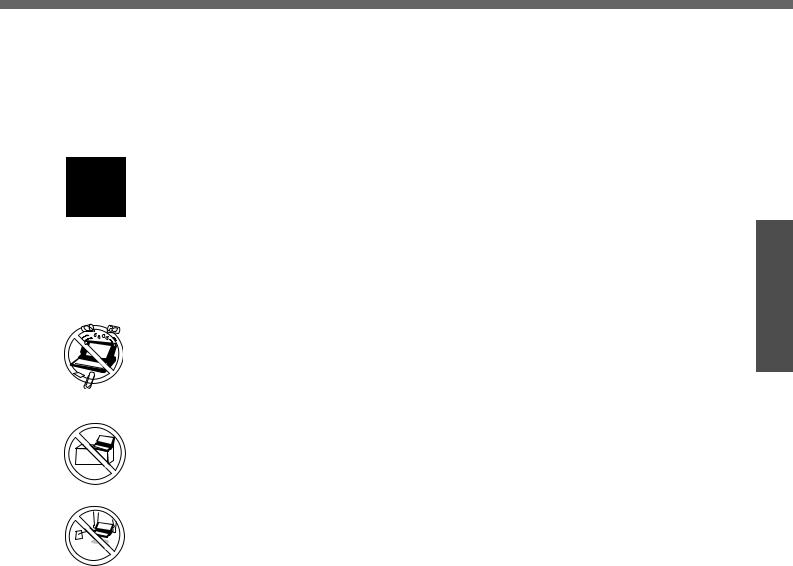
Clean the DC plug of dust and other debris regularly
If dust or other debris accumulates on the plug, humidity, etc. may cause a defect in the insulation, which may result in a fire.
zPull the plug, and wipe it with a dry cloth.
Pull the plug if the computer is not being used for a long period of time.
Do not pull or insert the DC plug if your hands are wet
May result in electrical shock.
Insert the AC plug completely
If the plug is not inserted completely, fire due to overheating or electrical shock may result.
zDo not use a damaged plug or loose electrical socket.
Do not place metal objects or containers of liquid on top of the computer
zIf water or other liquid spills, or if paper clips, coins, or other metal objects get inside the computer, fire or electrical shock may result.
Do not place the computer on unstable surfaces
If balance is lost, the computer may fall over or drop, resulting in an injury.
Do not move the computer while the DC plug is connected
The AC cord may be damaged, resulting in fire or electrical shock.
zIf the AC cord is damaged, remove the DC plug immediately.
Hold the plug when unplugging the AC cord
Pulling on the cord may damage the cord, resulting in a fire or electrical shock.
Do not turn the volume up to loud when using headphones
Listening at high volumes that overstimulate the ear for long periods of time may result in loss of hearing.
Take a break of 10-15 minutes every hour
Using the computer for long periods of time may have detrimental health effects on the eyes or hands.
Do not cover the computer with a thick cloth, such as a blanket
Preparations
9
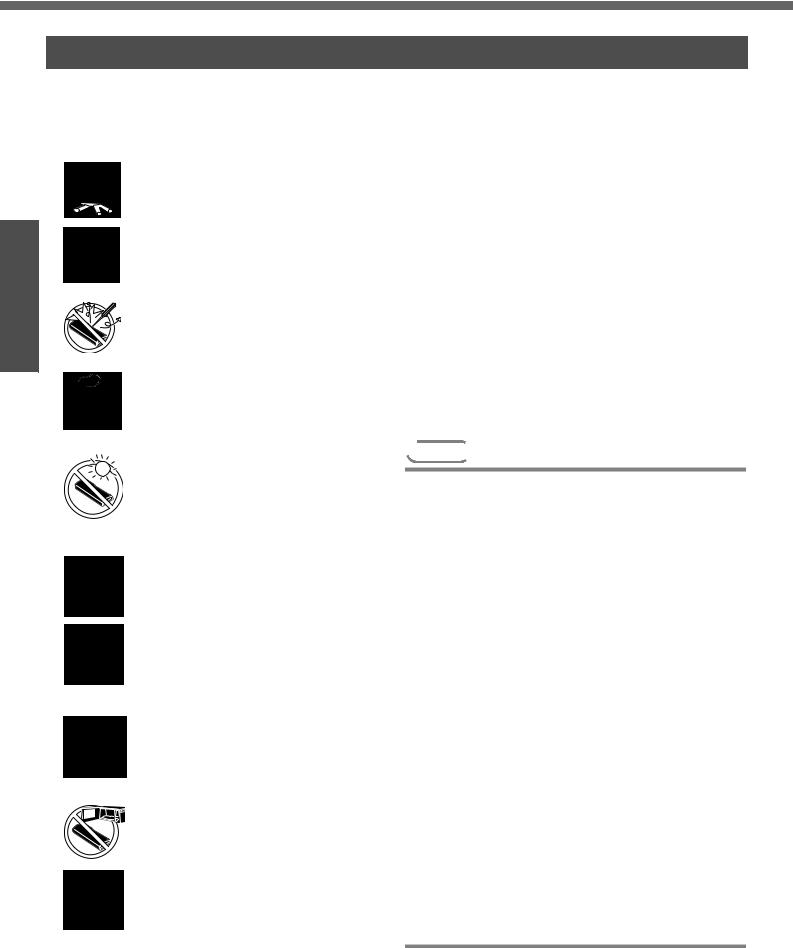
Read Me First
Preparations
Precautions (Battery Pack)
zCare should be exercised with regard to the following in order to avoid the possibility of overheating, fire or damage.
Avoid Heat
Do not throw the battery pack into a fire or expose it to excessive heat.
Keep Articles Away
Do not place the battery pack together with articles such as necklaces or hairpins when carrying or storing.
Do Not Disassemble
Do not insert sharp objects into the battery pack, expose it to bumps or shocks, deform, disassemble, or modify it.
Do Not Short
Do not short the positive (+) and negative (-) contacts.
Avoid Extreme Heat, Cold and Direct Sunlight
Do not charge, use or leave the battery pack for extended periods where it will be exposed to direct sunlight, in a hot place (in a car on a sunny day, for example), or in a cold place.
Do not charge the battery using the methods other than indicated in this manual
Do not use this computer with a battery pack other than the one specified (the one included with the computer or the specified battery pack sold separately)
Do Not Use With Any Other Computer
The battery pack is rechargeable and was intended for the specified computer. Do not use it with a computer other than the one for which it was designed.
Do Not Put into a Microwave
Do not put the battery pack into a microwave oven or a pressurized chamber.
Stop Using
Should the battery emit an abnormal odor, become hot to the touch, become discolored, change shape, or become in any way different from normal, remove it from the computer and stop using it.
zDo not touch the terminals on the battery pack. The battery pack may no longer function properly if the contacts are dirty or damaged.
zDo not expose the battery pack to water, or allow it to become wet.
zIf the battery pack will not be used for a long period of time (a month or more), charge or discharge (use) the battery pack until the remaining battery level becomes 30% to 40% and store it in a cool, dry place.
zThis computer prevents overcharging of the battery by recharging only when the remaining power is less than approx. 95% (when Economy Mode (ECO) is enabled: 75%) of capacity.
zThe battery pack is not charged when the computer is first purchased. Be sure to charge it before using it for the first time. When the AC adaptor is connected to the computer, charging begins automatically.
zShould the battery leak and the fluid get into your eyes, do not rub your eyes. Immediately flush your eyes with clear water and see a doctor for medical treatment as soon as possible.
 NOTE
NOTE 
zThe battery pack may become warm during recharging or normal use. This is completely normal.
zRecharging will not commence if internal temperature of the battery pack is outside of the allowable temperature range (0 °C to 55 °C {32 °F to 131 °F}). (Î "Battery Power" in onscreen Reference Manual) Once the allowable range requirement is satisfied, charging begins automatically. Note that the recharging time varies based on the usage conditions. (Recharging takes longer than usual when the temperature is 10 °C {50 °F} or below.)
zIf the temperature is low, the operating time is shortened. Only use the computer within the allowable temperature range.
zThe battery pack is a consumable item. If the amount of time the computer can be run by using a particular battery pack becomes dramatically shorter and repeated recharging does not restore its performance, the battery pack should be replaced with a new one.
zWhen transporting a spare battery inside a package, briefcase, etc., it is recommended that it be placed in a plastic bag so that its contacts are protected.
zAlways power off the computer when it is not in use. Leaving the computer on when the AC adaptor is not connected will exhaust the remaining battery capacity.
10
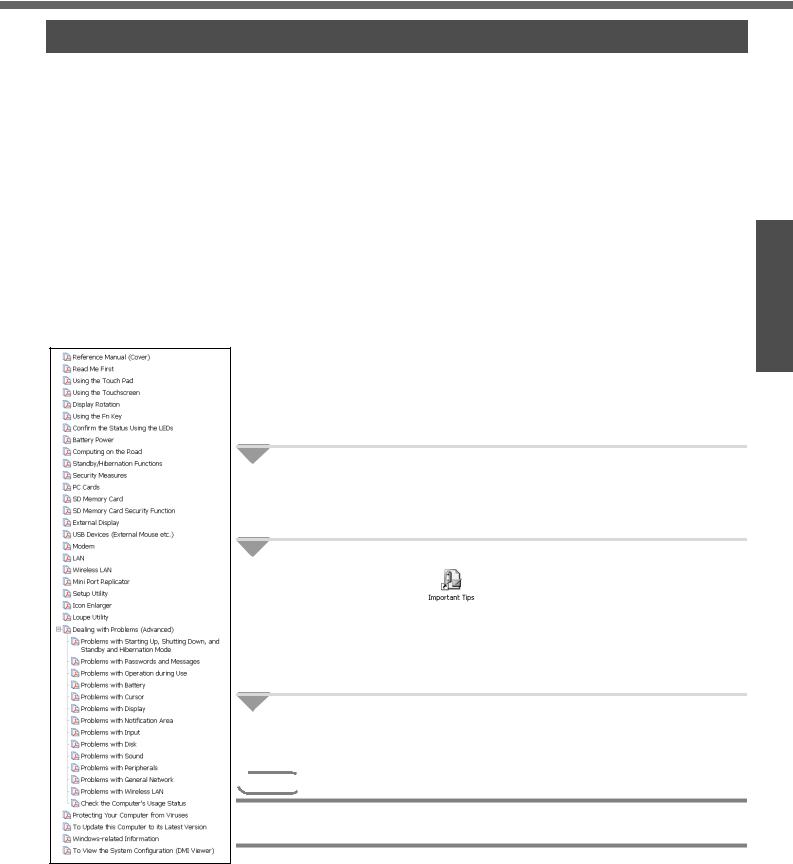
How to Use this Manual
Manual Types and Contents
Using the |
Operating Instructions |
This manual explains startup methods and basic operations required |
|
hard copy |
(This manual) |
|
when using the computer for the first time. |
|
Reference Manual |
The Reference Manual explains functions for you to make greater |
|
|
use of the computer, such as how to add peripheral devices, how the |
||
|
(PDF format) |
|
|
|
|
Setup Utility works, and other useful information. |
|
Using the |
|
|
|
|
|
|
|
|
|
Important Tips provides information on how to maximize use of the |
|
onscreen |
|
|
|
Important Tips |
|
battery pack, which is necessary for computing away from your home |
|
manual |
|
||
(PDF format) |
|
or office. It also offers helpful explanations on how to use the touch- |
|
|
|
||
|
|
|
screen more effectively. |
|
Windows Help |
|
Windows Help explains operations and functions about Windows. |
|
|||
How to Use the Onscreen Manual |
|||
Contents of the |
The manual is saved in the computer's hard disk. To view the manual, start up the |
||
Reference Manual |
computer after completing the settings for "First-time Operation" (Î page 14). |
||
zWhen the manuals in PDF format (see above) are accessed for the first time, the License Agreement of the Adobe Reader may be displayed. If it is displayed, after reading the agreement, click [Accept].
zRefer to Acrobat Reader Help to use the Acrobat Reader.
How to access the Reference Manual
1 Click [start] then click [Reference Manual].
How to access the Important Tips
1 Double-click the |
icon on the desktop. |
Important Tips can also be accessed from [start] - [All Programs] - [Panasonic] - [On-Line Manuals] - [Important Tips].
How to access Windows Help
1 Log on to Windows with the administrator authority and click [start] - [Help and Support].
 NOTE
NOTE 
zIf a user has logged on to Windows without the administrator authority, some parts in [Help and Support] cannot be displayed.
Preparations
11
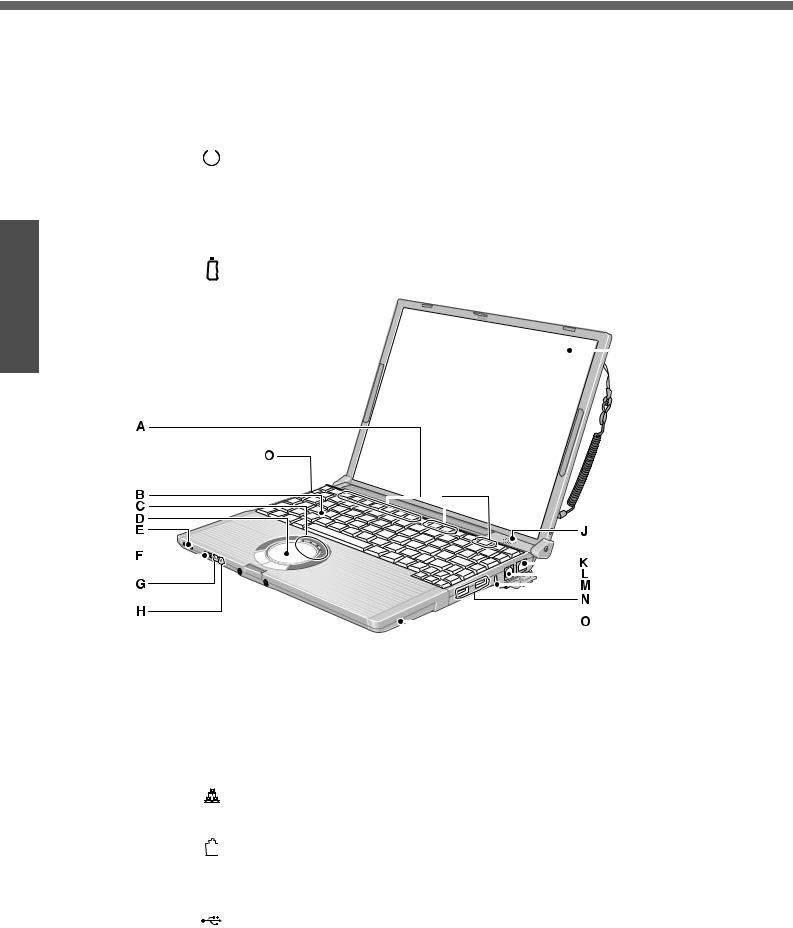
Names and Functions of Parts
Preparations
|
Names |
|
|
|
|
|
|
Functions/Reference |
|||||||||||||
A |
Function Keys |
|
|
|
Press a key in combination with the |
Fn |
key to execute the function allocated to that |
||||||||||||||
|
|
|
key. |
||||||||||||||||||
|
|
|
|
|
|
||||||||||||||||
|
|
|
|
|
|
|
|
|
|
|
|
|
|
|
|
|
|
|
|
|
|
B |
Keyboard |
|
|
|
— |
|
|
|
|
|
|
|
|
|
|
|
|
|
|
||
C |
LEDs |
|
|
|
Î “Confirm the Status Using the LEDs” in onscreen Reference Manual |
||||||||||||||||
|
|
|
|
|
|
|
|
|
|
|
|
|
|
|
|
|
|
||||
D |
Touch Pad |
|
|
|
Î page 23 |
||||||||||||||||
|
|
|
|
|
|
|
|
|
|
|
|
|
|
|
|
|
|
||||
E |
Power Switch/ |
|
|
|
Slide the switch for about one second to turn the power on. |
||||||||||||||||
|
|
|
|||||||||||||||||||
Power Indicator |
|
|
|
Î “Confirm the Status Using the LEDs” in onscreen Reference Manual |
|||||||||||||||||
F |
Wireless LAN |
WIRELESS LAN |
Slide the wireless LAN switch to turn the wireless LAN power on or off. |
||||||||||||||||||
Switch |
Î page 28 |
||||||||||||||||||||
|
|
|
|
|
|
|
|
|
|
|
|
|
|
|
|
|
|
|
|
|
|
G |
Economy Mode |
ECO |
Î |
“Confirm the Status Using the LEDs” in onscreen Reference Manual |
|||||||||||||||||
(ECO) Indicator |
|||||||||||||||||||||
|
|
|
|
||||||||||||||||||
|
|
|
|
|
|
|
|
|
|
|
|
|
|
|
|
|
|
||||
H |
Battery Indicator |
|
|
|
Î “Confirm the Status Using the LEDs” in onscreen Reference Manual |
||||||||||||||||
|
|
|
|
|
|
|
|
|
|
|
|
|
|
|
|
|
|
|
|
|
|
|
|
|
|
|
|
|
|
|
|
|
|
|
|
|
|
|
|
|
|
|
|
|
|
|
|
|
|
|
|
|
|
|
|
|
|
|
|
|
|
|
|
|
|
|
|
|
|
|
|
|
|
|
|
|
|
|
|
|
|
|
|
|
|
|
|
|
|
|
|
|
|
|
|
|
|
|
|
|
|
|
|
|
|
|
|
|
|
|
|
|
|
|
|
|
|
|
|
|
|
|
|
|
|
|
|
|
|
|
|
|
|
|
|
|
|
|
|
|
|
|
|
|
|
|
|
|
|
|
|
|
|
|
|
|
|
|
|
|
|
|
|
|
|
|
|
|
|
|
|
|
|
|
|
|
|
|
|
|
|
|
|
|
|
|
|
|
|
|
|
|
|
|
|
|
|
|
|
|
|
|
|
|
|
|
|
|
|
|
|
|
|
|
|
|
|
|
|
|
|
|
|
|
|
|
|
|
|
|
|
|
|
|
|
|
|
|
|
|
|
|
|
|
|
|
|
|
|
|
|
|
|
|
|
|
|
|
|
|
|
|
|
|
|
|
|
|
|
|
|
|
|
|
|
|
|
|
|
|
|
|
|
|
|
|
Display (Internal LCD/ |
To adjust the LCD brightness: |
Fn |
+ |
F1 |
(down) / |
Fn |
+ |
F2 |
(up) |
|||||||||||||||||
I |
z You can select a different brightness level setting for when the AC adaptor is con- |
||||||||||||||||||||||||||
Touchscreen) |
|||||||||||||||||||||||||||
|
|
|
|
|
|
nected and for when it is not connected. |
|||||||||||||||||||||
|
|
|
|
|
|
Î “Touchscreen” in onscreen Reference Manual |
|||||||||||||||||||||
|
|
|
|
|
|
|
|
|
|
|
|
|
|
|
|
||||||||||||
J |
Speaker |
z To adjust the volume: |
Fn |
+ |
F5 |
(down) / |
Fn |
+ |
F6 |
(up) |
|||||||||||||||||
|
|
|
|
|
|
|
|
|
|
|
|
|
|
|
|
|
|
|
|
|
|||||||
z Speaker on/off: Fn+F4 |
|||||||||||||||||||||||||||
|
|
|
|
|
|
||||||||||||||||||||||
|
|
|
|
|
|
Connect LAN cable. |
|||||||||||||||||||||
K |
LAN Port |
|
|
|
If the mini port replicator is connected to the computer, connect the LAN cable to the |
||||||||||||||||||||||
|
|||||||||||||||||||||||||||
|
|
|
|
|
|
LAN port on the mini port replicator. You cannot use the LAN port on the computer. |
|||||||||||||||||||||
|
|
|
|
|
|
||||||||||||||||||||||
|
|
|
|
|
|
Î “LAN” in onscreen Reference Manual |
|||||||||||||||||||||
|
|
|
|
|
|
|
|||||||||||||||||||||
L |
Modem Port |
Connect modem telephone cable. |
|||||||||||||||||||||||||
|
|
|
|
|
|
Î “Modem” in onscreen Reference Manual |
|||||||||||||||||||||
M |
Security Lock |
A Kensington cable can be connected. |
|||||||||||||||||||||||||
For more information, read the manual that comes with cable. |
|||||||||||||||||||||||||||
|
|
|
|
|
|
||||||||||||||||||||||
|
|
|
|
|
|
|
|||||||||||||||||||||
N |
USB Ports |
Connect the USB cable. |
|||||||||||||||||||||||||
|
|
|
|
|
|
Î “USB Devices (External Mouse etc.)” in onscreen Reference Manual |
|||||||||||||||||||||
O |
Wireless LAN Antenna |
This computer has a built-in antenna for wireless LAN communications. |
|||||||||||||||||||||||||
(built-in) |
Î “Wireless LAN” in onscreen Reference Manual |
||||||||||||||||||||||||||
|
|
|
|
|
|
|
|
|
|
|
|
|
|
|
|
|
|
|
|
|
|
|
|
|
|
|
|
12
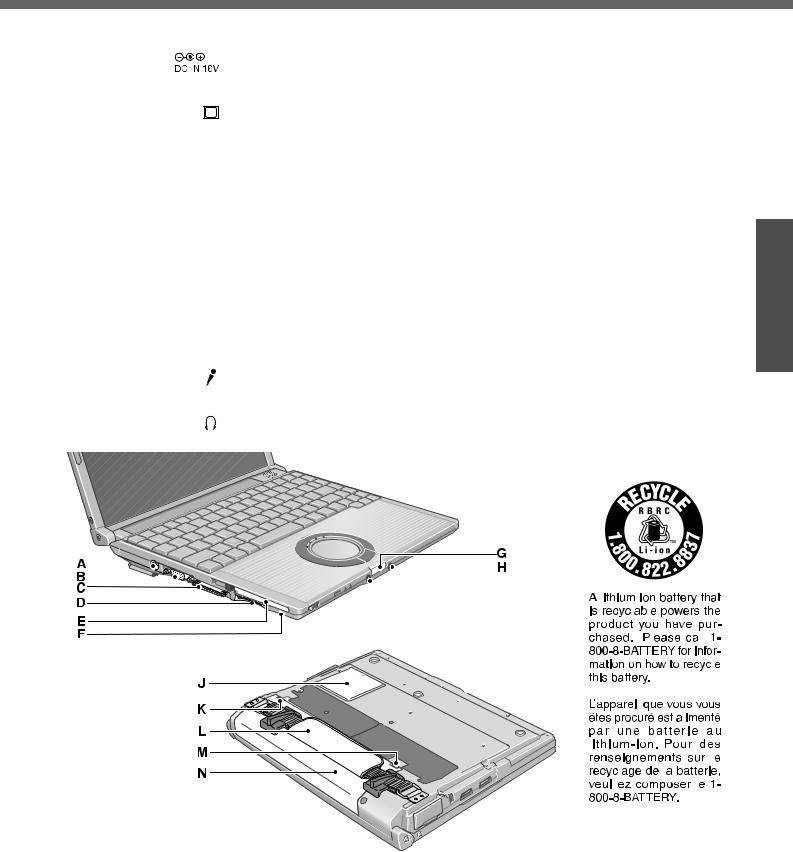
|
Names |
|
Functions/Reference |
||
A |
DC-IN Jack |
|
|
|
Connect the AC adaptor. Î page 15 |
|
|
||||
|
|
|
|
|
|
|
|
|
|
|
|
|
|
|
|
|
Connect the external display cable. |
|
External Display Port |
|
If the mini port replicator is connected to the computer, connect the external display to |
||
B |
|
the external display port on the mini port replicator. You cannot use the external display |
|||
|
|
|
|
|
port on the computer. |
|
|
|
|
|
Î “External Display” in onscreen Reference Manual |
|
|
|
|
|
|
C |
Mini Port Replicator |
EXT. |
Connect the Mini Port Replicator (optional) |
||
Connector |
|||||
|
|
|
|
|
|
D |
SD Memory Card Slot |
|
Î “SD Memory Card” in onscreen Reference Manual |
||
|
|
|
|
|
|
E |
PC Card Slot |
|
Î “PC Cards” in onscreen Reference Manual |
||
|
|
|
|
|
|
F |
SD Memory Card |
|
Î “Confirm the Status Using the LEDs” in onscreen Reference Manual |
||
Indicator |
|
||||
|
|
|
|
|
|
|
|
|
|
|
When the display is closed and the latch is locked, the computer goes into standby or |
G |
Latch |
|
hibernation mode. (Î “Standby/Hibernation Functions” in onscreen Reference Manual) |
||
|
z When the computer is in standby or hibernation mode, open the display to restart |
||||
|
|
|
|
|
|
|
|
|
|
|
operations. |
|
|
|
|
|
|
|
Microphone Jack |
|
Use only a monaural condenser microphone (miniature jack). Using an input source |
||
H |
|
other than a monaural condenser microphone may not allow audio to be input or may |
|||
|
|
|
|
|
damage the equipment. |
|
|
|
|
|
|
I |
Headphone Jack |
|
Use this jack to connect headphones or amplifier-equipped speakers. Audio output from |
||
|
|
|
|
|
the internal speaker is disabled when headphones or external speakers are connected. |
|
|
|
|
|
|
|
|
|
|
|
|
|
|
|
|
|
|
|
|
|
|
|
|
|
|
|
|
|
|
|
|
|
|
|
|
|
|
|
|
|
|
|
|
|
|
|
|
|
|
|
|
|
|
|
|
|
|
|
|
|
|
|
|
|
|
|
|
|
|
|
|
|
|
|
|
|
|
|
|
|
|
|
|
|
|
|
|
|
|
|
|
|
|
|
|
|
|
|
|
|
|
|
|
|
|
|
|
|
|
|
|
|
|
|
|
|
|
|
|
|
|
|
|
|
|
|
|
|
|
|
|
|
|
|
|
|
|
|
|
|
|
|
|
|
|
|
|
|
|
|
|
|
|
|
|
|
|
|
|
|
|
|
|
|
|
|
|
|
|
|
|
|
|
|
|
|
|
|
|
|
|
|
|
|
|
|
|
|
|
|
|
|
|
|
|
|
|
|
|
|
|
|
|
|
|
|
|
|
|
|
|
|
|
|
|
|
|
|
|
|
|
|
|
|
|
|
|
|
|
|
|
|
|
|
|
|
|
|
|
|
|
|
|
|
|
|
|
|
|
|
|
|
|
|
|
|
|
|
|
|
|
|
|
|
|
|
|
|
|
|
|
|
|
|
|
|
|
|
|
|
|
|
|
|
|
|
|
|
|
|
|
|
|
|
|
|
|
|
|
|
|
|
|
|
|
|
|
|
|
|
|
|
|
|
|
|
|
|
|
|
|
|
|
|
|
|
|
|
|
|
|
|
|
|
|
|
|
|
|
|
|
|
|
|
|
|
|
|
|
|
|
|
|
|
|
|
|
|
|
|
|
|
|
|
|
|
|
|
|
|
|
|
|
|
|
|
|
|
|
|
|
|
|
|
|
|
|
|
|
|
|
|
|
|
|
|
|
|
|
|
|
|
|
|
|
|
|
|
|
|
|
|
|
|
|
|
|
|
|
|
|
|
|
|
|
|
|
|
|
|
|
|
|
|
|
|
|
|
|
|
|
|
|
|
|
|
|
|
|
|
|
|
|
|
|
|
|
|
|
|
|
|
|
|
|
|
|
|
|
|
|
|
|
|
|
|
|
|
|
|
|
|
|
|
|
|
|
|
|
|
|
|
|
|
|
|
|
|
|
|
|
|
|
|
|
|
|
|
|
|
|
|
|
|
|
|
|
|
|
|
|
|
|
|
|
|
|
|
|
|
|
|
|
|
|
|
|
|
|
|
|
|
|
|
|
|
|
|
|
|
|
|
|
|
|
|
|
|
|
|
|
|
|
|
|
|
|
|
|
|
|
|
|
|
|
|
|
|
|
|
|
|
|
|
|
|
|
|
|
|
|
|
|
|
|
|
|
|
|
|
|
|
|
|
|
|
|
|
|
|
|
|
|
|
|
|
|
|
|
|
|
|
|
|
|
|
|
|
|
|
|
|
|
|
|
|
|
|
|
|
|
|
|
|
|
|
|
|
|
|
|
|
|
|
|
|
|
|
|
|
|
|
|
|
|
|
|
|
|
|
|
|
|
|
|
|
|
|
|
|
|
|
|
|
|
|
|
|
|
|
|
|
|
|
|
|
|
|
|
J |
RAM Module Slot |
|
Î page 24 |
||||||||||||||||||||||||
|
|
|
|
|
|
|
|
|
|
|
|
|
|
|
|
|
|
|
|
|
|
|
|
|
|
|
|
K |
Latch |
|
This latch is locked automatically when inserting the battery pack properly. |
||||||||||||||||||||||||
|
|
|
|
|
|
|
|
|
|
|
|
|
|
|
|
|
|
|
|
|
|
|
|
|
|
|
|
L |
Hand strap |
|
Î page 21 |
||||||||||||||||||||||||
M |
Latch |
|
This latch is locked manually when inserting/removing the battery pack. Î page 14 |
||||||||||||||||||||||||
|
|
|
|
|
|
|
|
|
|
|
|
|
|
|
|
|
|
|
|
|
|
|
|
|
|
|
|
N |
Battery Pack |
|
Î page 14, “Battery Power” in onscreen Reference Manual |
||||||||||||||||||||||||
|
|
|
|
|
|
|
|
|
|
|
|
|
|
|
|
|
|
|
|
|
|
|
|
|
|
|
|
Preparations
13

First-time Operation
Explains operating procedures from the time of purchase to the start of first Windows operations.
1 Confirm the inclusion of all parts.
Make sure the parts shown in the figure have been supplied. If any of these items are missing or is not working properly, contact your technical support office.
Preparations
2 Read the LIMITED USE LICENSE AGREEMENT (Î page 44).
Be sure to read the LIMITED USE LICENSE AGREEMENT before breaking the seal on the computer’s packaging.
3 Turn the computer over and insert the battery pack.
A Slide the left-side latch (A) to the unlock position  .
.
BMake sure the battery pack is facing the correct direction, slide it in the direction of the arrow.
C Slide the left-side latch to the lock position  , and then check to ensure that the battery pack is held firmly.
, and then check to ensure that the battery pack is held firmly.
(Right-side latch is locked automatically.)
CAUTION
zConfirm that the latch is properly locked. If it is not, the battery pack may come off while you are carrying the computer.
zDo not touch the terminals on the battery pack and the computer. The battery pack may no longer function properly if the contacts are dirty or damaged. Also, the computer may not operate properly.
zBefore using the battery pack, carefully read “Precautions (Battery Pack)” (Î page 10).
14
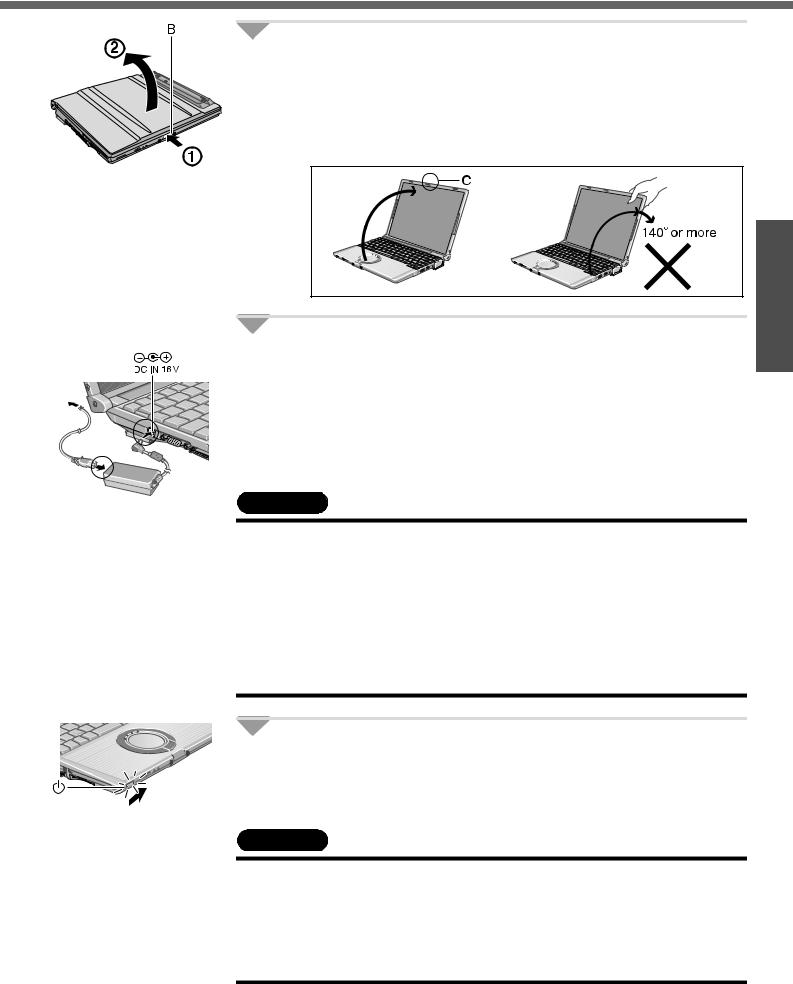
4 Open the display.
APress and hold the latch (B) located at the front.
BLift open the display.
z Do not open the display wider than necessary (140° or more), and do not apply excessive pressure to the LCD. Do not open or close the computer holding the edge of the LCD segment. Hold the C (below) segment to open or close the computer.
5 Connect your computer to a power outlet.
zBe sure the AC adaptor is connected until completing the first-time use operation.
zThe battery pack will be charged automatically.
Charging Time: Approx. 5 hours (Power off), Approx. 7 hours (Power on) (Varies depending on the usage conditions.)
zWhen using the computer for the first time, do not connect any peripheral device except the battery pack and AC adaptor to the computer.
CAUTION
Handling the AC adaptor
zDo not subject the AC adaptor to any strong impact.
Using the AC adaptor after a strong impact such as being dropped may result in electrocution, short circuit, or fire.
zUse only the specified AC adaptor with your computer. Using an AC adaptor other than the one supplied might damage the battery and/or the computer.
zProblems such as sudden voltage drops may arise during periods of thunder and lightning. Since this could adversely affect your computer, an uninterruptible power source (UPS) is highly recommended unless running from the battery pack alone.
Preparations
6 Turn your computer on.
zSlide the power switch  and hold it for approximately one second until the power indicator
and hold it for approximately one second until the power indicator  turns on before releasing it.
turns on before releasing it.
CAUTION
zDo not slide the power switch and hold it for more than four seconds; this will cause the power to be turned off forcibly.
zDo not slide the power switch repeatedly.
zDo not press any keys or touch the touch pad or touchscreen until [Windows XP Professional Setup] is displayed.
zDo not change the Setup Utility until completing step 7. If you do so, Windows setup may not operate properly.
15

First-time Operation
Preparations
7 Setup Windows.
Moving the cursor  or clicking buttons can be performed with the touch pad
or clicking buttons can be performed with the touch pad
(A) and left button (B).
zDuring operations, it may take some time before the next screen is displayed.
Wait, and do not press any keys, or touch the touch pad, or touchscreen, etc.
AAt [Welcome to the Windows XP Setup Wizard], click [Next].
BAfter reading the agreement, click [I accept this agreement], then click [Next].
z If [I don’t accept this agreement] is selected, the Windows setup will be aborted.
CSelect settings for your region, then click [Next].
DEnter your name and then click [Next]. (You do not need to enter your organization.)
EEnter your computer name and administrator password and then click [Next]. z "Computer name" is for recognizing this computer when multiple com-
puters are connected via the network.
z Remember this password! This password may be needed to manage the computer.
z Even if you go on to the next step without setting the password, you can set the password in the [Control Panel] after Windows setup is completed.
FEnter the correct date, time and the time zone, then click [Next].
z Click  or
or  to set.
to set.
z If set properly, click [Next].
zIt may take some time before the computer restarts. Wait, and do not press any keys, or touch the touch pad, touchscreen, etc.
zAfter being set automatically, the computer will restart automatically, and Windows will start.
GEnter your password set in step E and click  .
.
z When inputting the password, confirm that character input is not set to “Caps Lock” or “NumLk.”
 NOTE
NOTE 
zWhen Windows setup is completed
•The following message will be displayed at the bottom right of the screen: "Your computer might be at risk." Continue to the next step.
The message is generated by the [Security Center] function in [Control Panel], and does not indicate an error or malfunction. For more information about [Security Center]: Î page 30
16

8 Create "User Accounts" to recognize this computer's user.
zIf you make mail settings or execute other operations (password reset disk (Î page 18) etc.) before creating the user account, you will be unable to use mail history or settings. Create the user account at this time.
A Click [start]*1 - [Control Panel] - [User Accounts] - [Create a new account].
*1 Immediately after Windows setup, the screen may show a display as though [start] |
|
|
has been clicked (i.e., [All Programs] and other menus may be shown above |
|
|
[start]). |
|
|
B Enter a new name for the new account, then click [Next]. |
|
|
(For example: Matsushita) |
|
|
|
||
z The following character strings cannot be used as an account name |
Preparations |
|
because they are already being used by the computer system. |
||
CON, PRN, AUX, CLOCK$, NUL, COM1 - COM9, LPT1 - LPT9 |
||
|
||
C Click [Create Account]. |
|
|
z When you create the first new account, you can only select [Computer |
|
|
administrator]. |
|
|
Once a “Computer Administrator” account has been created, you can |
|
|
create additional limited user accounts. |
|
|
D Set the password. |
|
|
z When sharing this computer with multiple users, we recommend set- |
|
|
ting a password for your own account. |
|
|
z When setting password, click the account for which you will set the |
|
|
password, click [Create a password], and the password following the |
|
|
onscreen instructions, and click [Create Password]. |
|
|
• Remember the password you have set. It is useful to input a hint in |
|
|
[password hint] in case you forget your password. In addition, we rec- |
|
|
ommend that you create a password reset disk beforehand (Î page |
|
|
18). |
|
|
Refer to “When the administrator password is forgotten” (Î page 36) |
|
|
in “Dealing with Problems (Summary).” |
|
|
E Click [start] - [Turn Off Computer] - [Restart] to restart the computer. |
|
|
F At the Welcome screen, click the created user (user icon) to log-on. |
|
z If the password has been set, enter the password and click  . You cannot operate the computer until the proper password is entered. Confirm that character input is not set to "Caps Lock" or "NumLk."
. You cannot operate the computer until the proper password is entered. Confirm that character input is not set to "Caps Lock" or "NumLk."
zNote also that only the added user account will be displayed in the Welcome screen. The account for the administrator created during Windows setup will not be displayed.
9 Calibrate the touchscreen.
AClick [start] - [All Programs] - [Fujitsu Touch Panel (USB)] - [Touch Screen Calibration Utility].
BTouch the "+" target mark and keep touching it until it blinks. Repeat this operation for all 12 "+" target marks, then press the Enter key.
CSelect [Save & Exit].
 NOTE
NOTE 
z Calibrate the touchscreen for each account created.
This concludes the first-time use operation guidelines.
17
